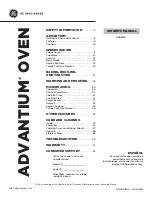
R-351NW
When troubleshooting the microwave oven, it is helpful to follow the Sequence of Operation in performing the checks. Many of the
possible causes of trouble will require that a speci
fi
c test be performed. These tests are given a procedure letter which will be found in
the “Test Procedure” section.
IMPORTANT:
If the oven becomes inoperative because of a blown monitor fuse, check the monitor switch, primary interlock relay (RY2), door
sensing switch and secondary interlock switch before replacing the monitor fuse. If monitor fuse is replaced, the monitor switch must
also be replaced. Use part QFS-BA009WRE0 and QSW-MA086WRE0 as an assembly.
7 - 1
CHAPTER 7. TROUBLESHOOTING GUIDE
Never touch any part in the circuit with your hand or an uninsulated tool while the power supply is connected.
IMPORTANT:
Whenever troubleshooting is performed with the power supply
cord disconnected. It may in, some cases, be necessary to
connect the power supply cord after the outer case has been
removed, in this event,
1) Disconnect the power supply cord, and then remove outer
case.
2) Open the door and block it open.
3) Discharge high voltage capacitor.
4) Disconnect the leads to the primary of the power transformer.
5) Ensure that the leads remain isolated from other components
and oven chassis by using insulation tape.
6) After that procedure, reconnect the power supply cord.
When the testing is completed,
1) Disconnect the power supply cord, and then remove outer case.
2) Open the door and block it open.
3) Discharge high voltage capacitor.
4) Reconnect the leads to the primary of the power transformer.
5) Reinstall the outer case (cabinet).
6) Reconnect the power supply cord after the outer case is
installed.
7) Run the oven and check all functions.
[1] TROUBLESHOOTING CHART
RE CK A
B
C
D
E
F
F
G
H RE RE CK J CK CK CK K
L
N
I
POSSIBLE CASE
AND DEFECTIVE PARTS
D
R
O
C
R
E
W
O
P
NI
T
R
O
H
S
G
NI
RI
W
D
E
N
E
P
O
R
O
T
R
O
H
S
N
O
R
T
E
N
G
A
M
R
E
M
R
O
F
S
N
A
R
T
R
E
W
O
P
Y
L
B
M
E
S
S
A
R
EI
FI
T
C
E
R
.
V.
H
R
O
TI
C
A
P
A
C
E
G
A
T
L
O
V
H
GI
H
E
S
U
F
E
R
U
T
A
R
E
P
M
E
T
T
U
O-
T
U
C
L
A
M
R
E
H
T
r
o
M
E
T
S
Y
S
K
C
O
L
R
E
T
NI
Y
R
A
MI
R
P
H
C
TI
W
S
K
C
O
L
R
E
T
NI
Y
R
A
D
N
O
C
E
S
H
C
TI
W
S
R
O
TI
N
O
M
E
S
U
F
R
O
TI
N
O
M
P
M
A
L
N
E
V
O
R
O
T
O
M
N
A
F
G
NI
L
O
O
C
R
O
T
O
M
E
L
B
A
T
N
R
U
T
L
E
N
A
P
L
O
R
T
N
O
C
H
C
U
O
T
N
OI
T
A
R
E
P
O
G
N
O
R
W
E
G
A
T
L
O
V
W
O
L
Y
TI
V
A
C
N
E
V
O
Y
T
RI
D
)
H
C
TI
W
S
E
N
A
R
B
M
E
M(
TI
N
U
Y
E
K
)
1
Y
R(
Y
A
L
E
R
B
W
P
N
O
N
R
E
T
T
A
P
LI
O
F
R
E
T
LI
F
E
SI
O
N
CONDITION
PROBLEM
OFF
CONDITION
TEST PROCEDURE
COOKING
CONDITION
M
T
S
O
R
F
E
D
Home fuse or circuit breaker blows when
power cord is plugged into wall receptacle
Monitor fuse blows when power cord is plug-
ged into wall receptacle.
All letters and indicators do not appear in dis-
play when power cord is first plugged into
wall outlet.
Display does not operate properly when
STOP/CLEAR key is touched. (Buzzer
should sound and ":" or time of day should
appear in display.)
Oven lamp does not light when door is
opened.
Oven lamp does not go out when door is
closed.
Oven lamp lights but fan motor and turntable
motor do not operate.
Oven does not go into cook cycle when
START pad is touched
Oven seems to be operating but little or no
heat is produced in oven load. (Food incom-
pletely cooked or not cooked at all at end of
cook cycle.)
Oven goes into a cook cycle but extremely
uneven heating is produced in oven load
(food).
Oven does not cook properly when program-
med for Cooking Power P-50 mode. (Oper-
ates properly on Cooking Power P-HI (HIGH)
mode.)
Oven goes into DEFROST but food is not
defrosted well.
Service_R-351NW.indd 13
Service_R-351NW.indd 13
6/26/09 6:30:51 PM
6/26/09 6:30:51 PM














































